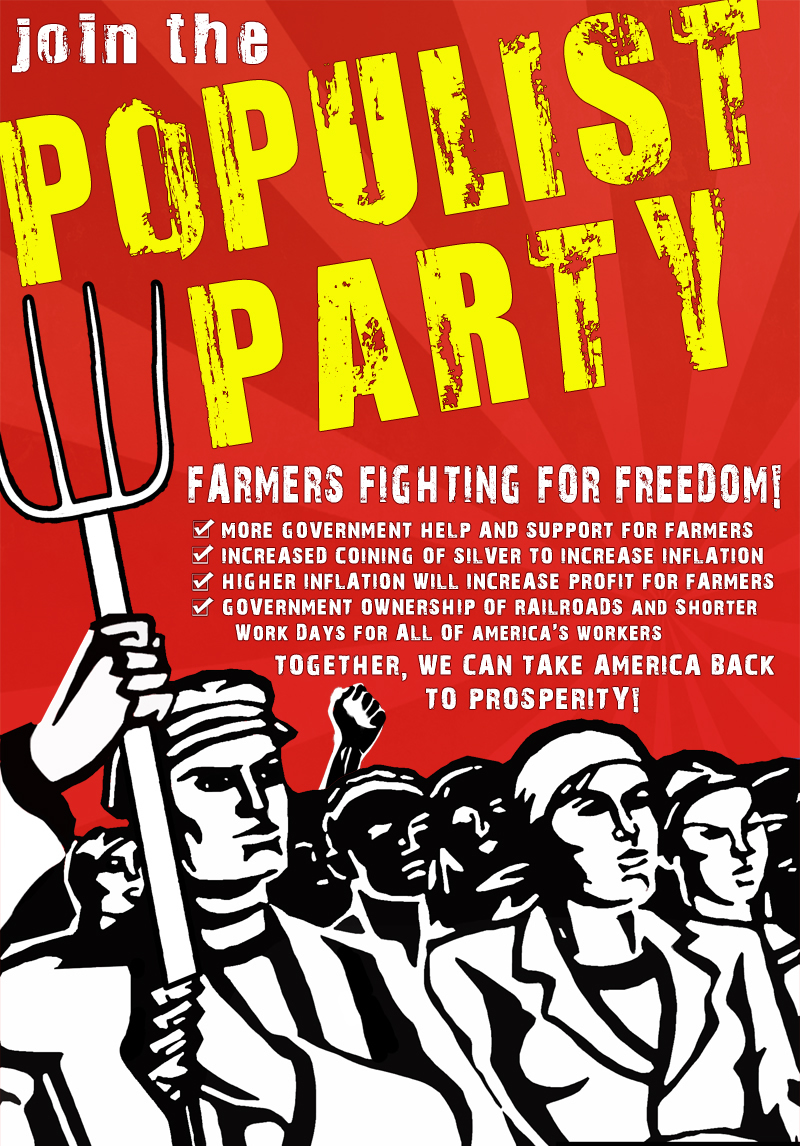 |
| Populism |
The agrarian movement in the West, South, and mountain regions of the United States in the late nineteenth century, known as Populism, contained several elements of conspiracy thinking directed at New York City, politicians, and the railroads.
Although mainstream Populists did not generally embrace the notion of a “New York money power,” many nevertheless were convinced that powerful forces had united to oppress farmers, miners, and industrial workers.
This sentiment was epitomized in the 1896 speech at the Democratic convention in which William Jennings Bryan, the party’s nominee for president, warned that these forces “will not crucify mankind on a cross of gold.”
  |
Following the Civil War, a general price deflation set in that especially hurt farmers who had long-term (five- to fifteen-year) mortgages by making the dollars they repaid much more valuable than the dollars they borrowed. At the same time, new silver discoveries in the West unleashed a torrent of silver onto the market.
Advocates for farmers and debtors saw a way to combine the blessings of silver and the plight of the farmers by monetizing silver at a fixed rate of 16:1 (or sixteen silver ounces for one ounce of gold). In fact, the market rate was closer to 17:1, but the “silverites” hoped to force the government to purchase the silver at inflated prices, thus putting more money into the economy, especially in the West.
At the same time, agrarians became concerned about the level of prosperity in railroads and banking while agriculture—the backbone of the Republic since Jefferson’s time—languished. As the historian of the Populist movement, John D. Hicks, noted, the farmer believed that he “worked longer hours, under more adverse conditions, and with smaller compensation for his labor than any other man on earth.”
Farmers also felt exploited by the railroads and grain elevators, which they deemed to have a “monopoly
Complaints about the railroads were preeminent within the young Populist Party. The party originated with various farmers’ organizations, such as the National Farmers’ Alliance and the National Farmers’ Alliance and Industrial Union, as well as local antimonopoly parties, such as the People’s Anti-monopoly Party in Minnesota, the National Greenback Party, and the local Grange organizations.
Various groups met in 1889, and the national convention of the “People’s Party of the U.S.A.,” known as the “Populists,” met in May 1891 to draw up a platform and nominate a candidate.
Key leaders of the agrarian movement were present, including Ignatius Donnelly of Minnesota, “Sockless Jerry” Simpson of Kansas, Tom Watson of Georgia, and James Weaver of Iowa. The convention nominated Weaver to run on a platform that demanded “free and unlimited coinage of silver at 16:1,” an income tax, and restrictions on immigrants.
Although the platform did not specify government ownership of the railroads, mainstream Populists all agreed on that measure as well, but most agreed it was not likely in the near future, and they therefore settled for government regulation of the railroads.
Weaver, of course, had no impact on the 1892 election. Congress had already passed the Sherman Silver Purchase Act
This created a window for arbitrage among speculators, resulting in a massive outflow of gold from the United States Treasury and major banks and triggering the panic of 1893. Although Congress repealed the act that year, the damage had been done and the erosion of the gold reserve undermined the nation’s banking system.
The panic gave the Republicans a campaign issue—the gold standard—and the Democrats took the bait by nominating William Jennings Bryan, a Democrat with strong populist leanings, as their presidential standard bearer. Bryan’s positions so closely paralleled those of the Populist Party that it did not nominate its own candidate, but supported Bryan.
At the convention, Bryan delivered his famous speech in which he railed at those who would impose the gold standard and “crucify mankind upon a cross of gold.” The Populists did gain control of some legislatures and judgeships, passing a law in Nebraska that imposed a cut in railroad freight rates.
But railroad and elevator freight rates had taken a backseat to the silver issue. Moreover, as reform elements within the Republican Party gained momentum, the Populists lost ground.
Unable to win at the ballot box with any regularity, they faced either fusion into the Democratic Party or allying themselves with the hated Republicans, who were actually enacting reforms. And despite the original lofty goals of a party that had no discrimination between races, the southern Populists had much different attitudes than those in the Midwest.
The Populists embodied the late-nineteenth-century agrarian anxiety about the declining status of the farmer in U.S. society. Farmers had gone into the Civil War era as a majority, and had controlled the electoral college through the votes of the South, West, and Midwest—all essentially hinging on the power of the farm bloc.
But after the Civil War, the United States shifted to a manufacturing society, and farm states lost their electoral clout. While literature and culture still held the farmer in high esteem, neither his income nor his political power seemed to confirm that status.
This produced an anxiety noted by Richard Hofstadter in his Age of Reform (1955)
Along with railroads, banks increasingly became targets for agrarian attacks. The unwillingness to permit branch banking ensured that in the Midwest especially, small country banks relied ever more heavily on big-city banks, particularly those in New York City. This, in turn, magnified conspiracy theories involving a “money trust” or “Jewish bankers” who controlled the nation’s finances.
Publications such as William “Coin” Harvey’s Coin’s Financial School (1894) contributed to such views. Like other third parties in U.S. history, however, the Populists melted into one or the other of the two established parties, and had largely disappeared by 1900... except in the fictional account of Frank Baum.